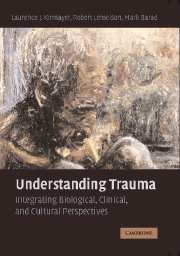Book contents
- Frontmatter
- Contents
- List of Figures
- List of Tables
- List of Contributors
- Foreword by Robert Jay Lifton
- Preface
- List of Abbreviations
- Introduction: Inscribing Trauma in Culture, Brain, and Body
- SECTION I NEUROBIOLOGICAL PERSPECTIVES ON TRAUMA
- SECTION II CLINICAL PERSPECTIVES ON TRAUMA
- 8 Cognitive Behavioral Treatments for Posttraumatic Stress Disorder
- 9 PTSD Among Traumatized Refugees
- 10 PTSD: A Disorder of Recovery?
- 11 The Developmental Impact of Childhood Trauma
- 12 Adaptation, Ecosocial Safety Signals, and the Trajectory of PTSD
- 13 Religion and Spirituality After Trauma
- 14 Posttraumatic Suffering as a Source of Transformation: A Clinical Perspective
- SECTION III CULTURAL PERSPECTIVES ON TRAUMA
- Epilogue: Trauma and the Vicissitudes of Interdisciplinary Integration
- Glossary
- Index
- References
14 - Posttraumatic Suffering as a Source of Transformation: A Clinical Perspective
Published online by Cambridge University Press: 27 July 2009
- Frontmatter
- Contents
- List of Figures
- List of Tables
- List of Contributors
- Foreword by Robert Jay Lifton
- Preface
- List of Abbreviations
- Introduction: Inscribing Trauma in Culture, Brain, and Body
- SECTION I NEUROBIOLOGICAL PERSPECTIVES ON TRAUMA
- SECTION II CLINICAL PERSPECTIVES ON TRAUMA
- 8 Cognitive Behavioral Treatments for Posttraumatic Stress Disorder
- 9 PTSD Among Traumatized Refugees
- 10 PTSD: A Disorder of Recovery?
- 11 The Developmental Impact of Childhood Trauma
- 12 Adaptation, Ecosocial Safety Signals, and the Trajectory of PTSD
- 13 Religion and Spirituality After Trauma
- 14 Posttraumatic Suffering as a Source of Transformation: A Clinical Perspective
- SECTION III CULTURAL PERSPECTIVES ON TRAUMA
- Epilogue: Trauma and the Vicissitudes of Interdisciplinary Integration
- Glossary
- Index
- References
Summary
When confronted with catastrophic trauma, our immediate response as clinicians is to focus on efforts to ensure survival. Organized violence, such as warfare, provokes a wide range of responses, including the urgent, moral need to condemn such crimes against humanity. The emergency pushes us to rely on our previously acquired knowledge and know-how. Once the initial crisis has faded, however, we tend to neglect the equally important task of creating spaces in which to rethink and adapt our interventions.
In order to work effectively in the field of trauma, we need to locate and identify our roles as clinicians and as members of institutions in a particular sociopolitical, historical, and cultural discourse on trauma. Contextualization is a necessary prerequisite to effective clinical work in trauma therapy. An important part of our work involves a continual questioning and examination of the complexity of social violence, including our own implicit role in the process, in order to avoid unwitting participation in the very forms of social violence we seek to address (Kleinman & Kleinman, 1997a). We also recognize that we need to strike a delicate balance between questioning the dominant models and supporting them. When models are too severely questioned and when the necessarily aggressive aspects of all types of treatment are too harshly critiqued, there is a real risk that the criticism will provoke a state of paralysis and a withdrawal of efforts to address the origins and consequences of organized violence.
- Type
- Chapter
- Information
- Understanding TraumaIntegrating Biological, Clinical, and Cultural Perspectives, pp. 275 - 294Publisher: Cambridge University PressPrint publication year: 2007
References
- 40
- Cited by

